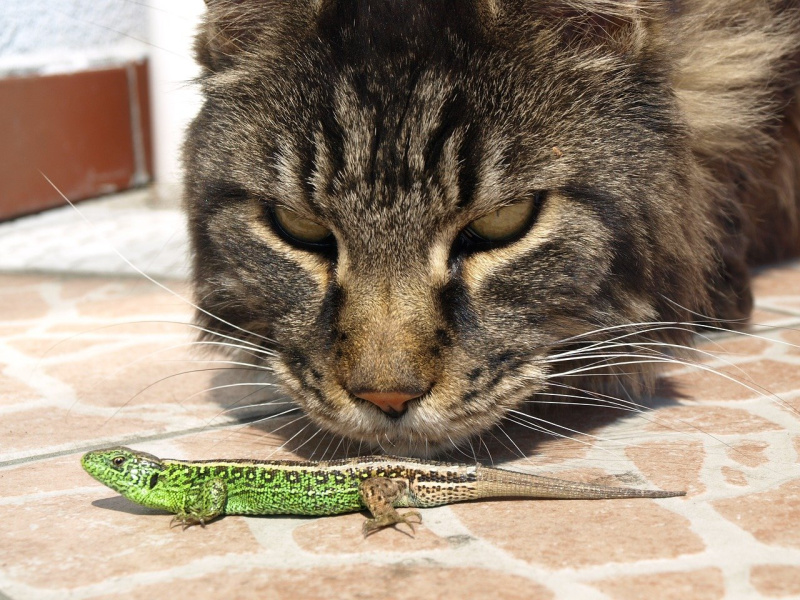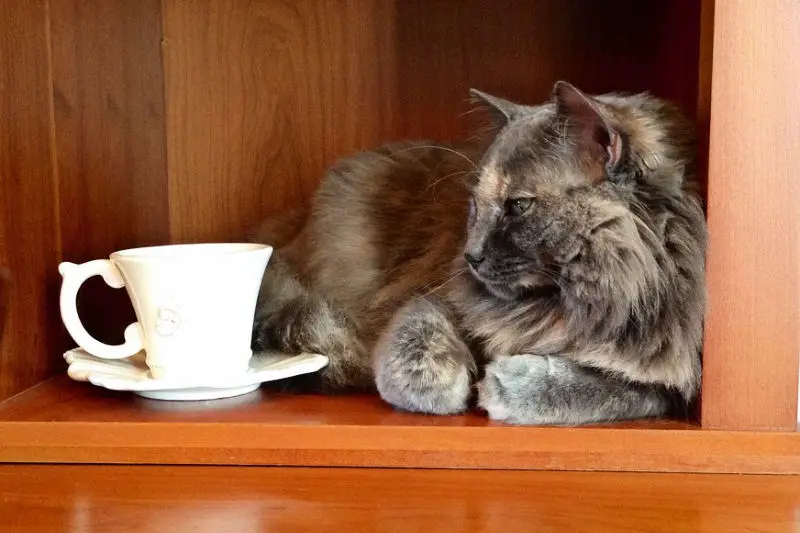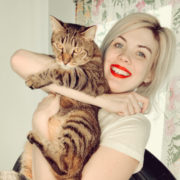Cats and lizards don’t have to be enemies and pet lizards have even been known to form strong bonds with their feline siblings. In fact, isn’t uncommon to see pictures of cats and Bearded Dragons cuddling!
While these species can be friends, forging a friendship will depend entirely on your pet’s personalities and how you go about introducing them. Some cats simply don’t like lizards and that can’t really be changed, but how you introduce them can have a big impact on their relationship.

If you plan introducing your pets there are a few common mistakes that people make that can set your pets up for failure. However, if you know how to avoid them, you are one step closer to building a interspecies friendship.
If seeing your cat cuddled up to your new lizard seems like something you want, keep reading!
5 Mistakes:
- Introducing your pets without a barrier– If you are hoping to introduce your cat to your pet lizard for the first time, you should always make that introduction through a barrier. This barrier will make the initial encounter a lot safer for both pets. Keeping your lizard in a glass enclosure or behind a screen door will help prevent a negative encounter. If you are introducing your pets and something goes wrong, for example your cat may lunge at a new lizard when it moves, then the barrier will prevent the cat from making direct contact and possibly hurting lizard.
- Not understanding your pet’s behavior– The best thing you can do before introducing your cat to their new reptilian sibling is understand their behavior. Knowing what your animals look like when they are stressed, angry, calm or aggravated can help you determine how successful the encounter is going. If you introduce your cat to your new Bearded Dragon and your cat is hissing, growling, and displaying stiff body posture, it is likely very uncomfortable with the new animal. On the other hand, if your Bearded Dragon’s beard is turning black, they are head bobbing or hissing they are likely stressed and uncomfortable as well. If you are introducing your cat to a Leopard Gecko, you may see them gape their mouths and wave their tail if distressed. Learning these cues can help you stop a negative encounter before it turns dangerous.
- Leaving them alone together- One of the biggest mistakes you can make is leaving your cat and lizard alone together. Even if it seems they have formed a close bond and enjoy each other’s company, leaving them unsupervised can turn dangerous quickly. While it is unlikely your cat will be harmed, your lizard can be severely injured or even killed by an angry cat. All interactions between your cat and lizard should be supervised. With supervision you can quickly step in and stop a bad situation from getting worse.
- Forcing a relationship– If your cat doesn’t like your new Bearded Dragon or vice versa, there isn’t much you can do to change that. If you have properly introduced your pets and they just don’t seem to like each other, don’t force their relationship. Trying to forge a friendship between your lizard and cat when both participants are unwilling is a recipe for disaster. Forcing interactions will likely only stress out both pets and cause tensions to rise within your household. In these cases, it will be best to keep your pets separated. This may mean they need to be in separate rooms completely. Always listen to what your pets are trying to tell you, and if they are saying “I don’t like this” you should respect them and listen.
- Not giving your pets their own space– Most animals are territorial and be more aggressive if they think other animals are infringing on their territory. Because of this, you may find some tension if you introduce animals in their own space. For example, bringing your new Leopard Gecko into your cat’s favorite cat tree may make your cat act aggressively. On the other hand, if your cat finds its way into your new Bearded Dragons enclosure, you may see your lizard head bobbing and threatening the intruder. Avoid introducing animals in rooms where they eat and sleep as they often view these areas as their territory. So, if you are thinking about setting up your new lizard’s enclosure in rooms where your cat eats or sleeps, try finding more neutral locations. Neutral areas can be spaces like offices or guest bedrooms where both pets don’t eat, sleep or frequent often. These neutral spaces are ideal to introduce your pets for the first time where both parties will feel comfortable.
Introducing your cat to your new lizard can be daunting, but if you introduce them properly your odds of success increase exponentially.

The first time you introduce your cat to your lizard you should provide a barrier in between them for safety. You should also know what stressed behavior looks like so you can tell if this interaction is making them unhappy. When introducing your pets you should avoid introducing them in areas where they sleep or eat since that can increase the chances your animals become territorial. Even if your pets form a close bond, never leave them alone together as that can be dangerous for both parties if things go wrong.

Lastly, don’t force your pets to be friends if they don’t want to. Some pet’s personalities just don’t mesh well and that’s okay.
Avoid these mistakes and your cat could be cuddling with your Bearded Dragon in no time!
This guest post was kindly contributed by a lifelong reptile lover who has kept pet lizards since childhood. He requested to remain anonymous.




Wow amazing info. I think my cat would be terrified of the bigger lizards. As for the smaller ones, I try and rescue as many of them as I can from her. She goes on the patio and then brings them in the house. I have rescued a lot, my daughter has to. We swoop them up in a jar and put them out in the grass. Some lizards I can’t get to before Luna does. We’re going to be sealing up holes and gaps in the patio so hopefully lizards, salamanders and baby frogs won’t be entering into Luna’s domain and end up in my house.
By chance could you make a video? And make sure it is noticeable like the name of the video could be “How to introduce your leopard gecko to your cat” and make sure it’s obvious to know that it’s made by you because try to add something that will make it noticeable, especially since I am requesting it and I don’t know exactly which video to press.
i absolutely love bearded dragons they are the number one most friendly reptiles and they are so cute! thanks for the cute little pictures!